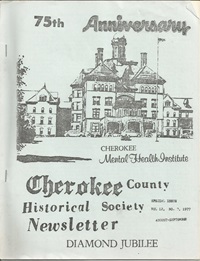|
Cherokee
Mental Health Institute
|
Compiled
and written by The Cherokee County Historical Society
for
their Diamond Jubilee edition of their newsletter
Vol 12, No. 7, 1977 August - September |

|
PREFACE
This issue
of the newsletter is devoted entirely to a single subject, the Cherokee
Mental Health Institute. For 75 years that institution has been a part
of Cherokee County life. Just as everything else has changed in three
quarters of a century so has the “City on the Hill” undergone many
changes.
When
the institution was built it was called the Cherokee State Hospital for
the Insane. Today, of course, it is known as the Cherokee Mental Health
Institute. More than the name has undergone change. The treatment
programs are far different, the large farm and industry programs which
made the state hospital almost self-sufficient, have long since been
disposed of. It would be easy to become very philosophical about what
changes the next 75 years will bring, but we have tried to avoid that
and stick to the history of the institution.
In
this issue we have tried to bring together a representative group of
materials from several sources to accurately reflect seventy-five years
of history. These
sources include the 1914 McCulla History of Cherokee County, Iowa; the
files of the Cherokee Times; the Cherokee Semi-Weekly Democrat; the
Cherokee Daily Times; the Centennial issue of the Cherokee Daily Times;
source material at the Mental Health Institute and personal interviews.
The front cover drawing is a portion of a drawing that appeared in the
special feature on the Mental Health Institute printed by the Cherokee
Daily Times. We thank Mr. Tom Miller and Mike Brown, the artist for
permission to use it. If you look
closely at the cover drawing you will note the old cannon guarding the
entrance. For years this relic of the civil war was a fixture near the
flag pole. Some years ago, the cannon was moved to Spring Lake Park.
The
drawing also shows the large dome which once crowned the administration
building. Some years ago, this too was removed as its condition and
great weight was weakening the whole structure.
The
original furnishings have long since entered the category of antiques
or at least collectibles. Some of them have been restored and are in
use on the second floor of the administration building, others have
found their way into the museum maintained by the hospital.
While doing
the research for this issue much anecdotal material about the hospital
came to light. Unfortunately, time and space did not allow for its
inclusion in this special issue. Many of the leads discovered we hope
to follow up with tape interviews for our archives or having them
written up for inclusion in future newsletters.
Although
the State Hospital opened its doors seventy-five years ago, we were
able to locate people who remembered the arrival of the first patients.
We were able to find and interview an employee who went to work at the
institution 70 years ago, and who knew and remembered many of the
principal actors of those early years.
Tom
McCulla Cherokee chief lobbyist in the struggle to secure the hospital
for this city has long ago passed to his reward. He was for many years
the Editor of the Cherokee Times and was the author of the 1914 History
of Cherokee County, Iowa.
Wireman
Miller the veteran and farmer who represented Cherokee in the General
Assembly has also long since died.
The
fruits of their labors, the Cherokee Mental Health Institute has been
for many years one of the chief employers of Cherokee. Its fate and
problems as well as its triumphs have been those of the community as
well.
By:
George K. Pettengill
|